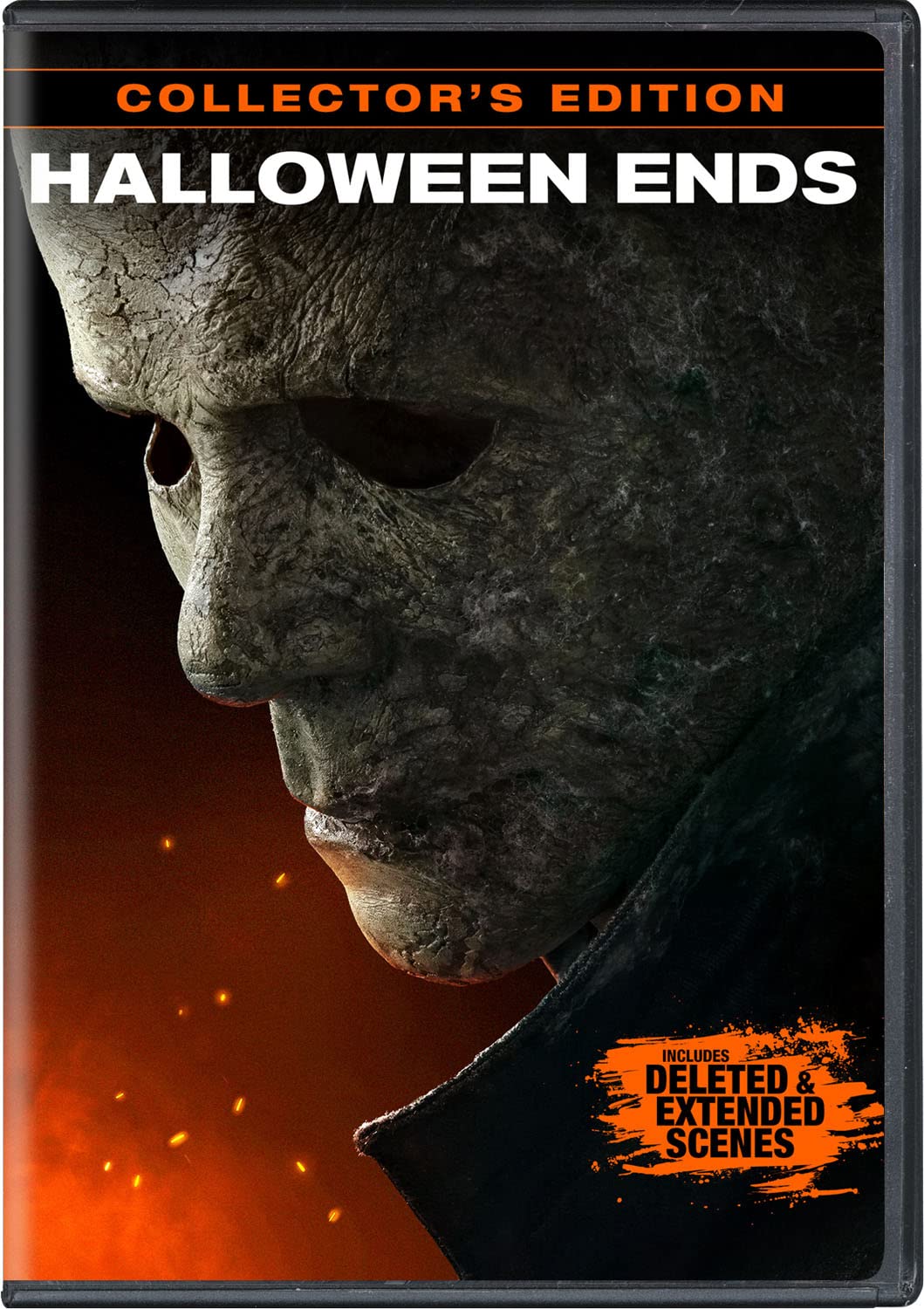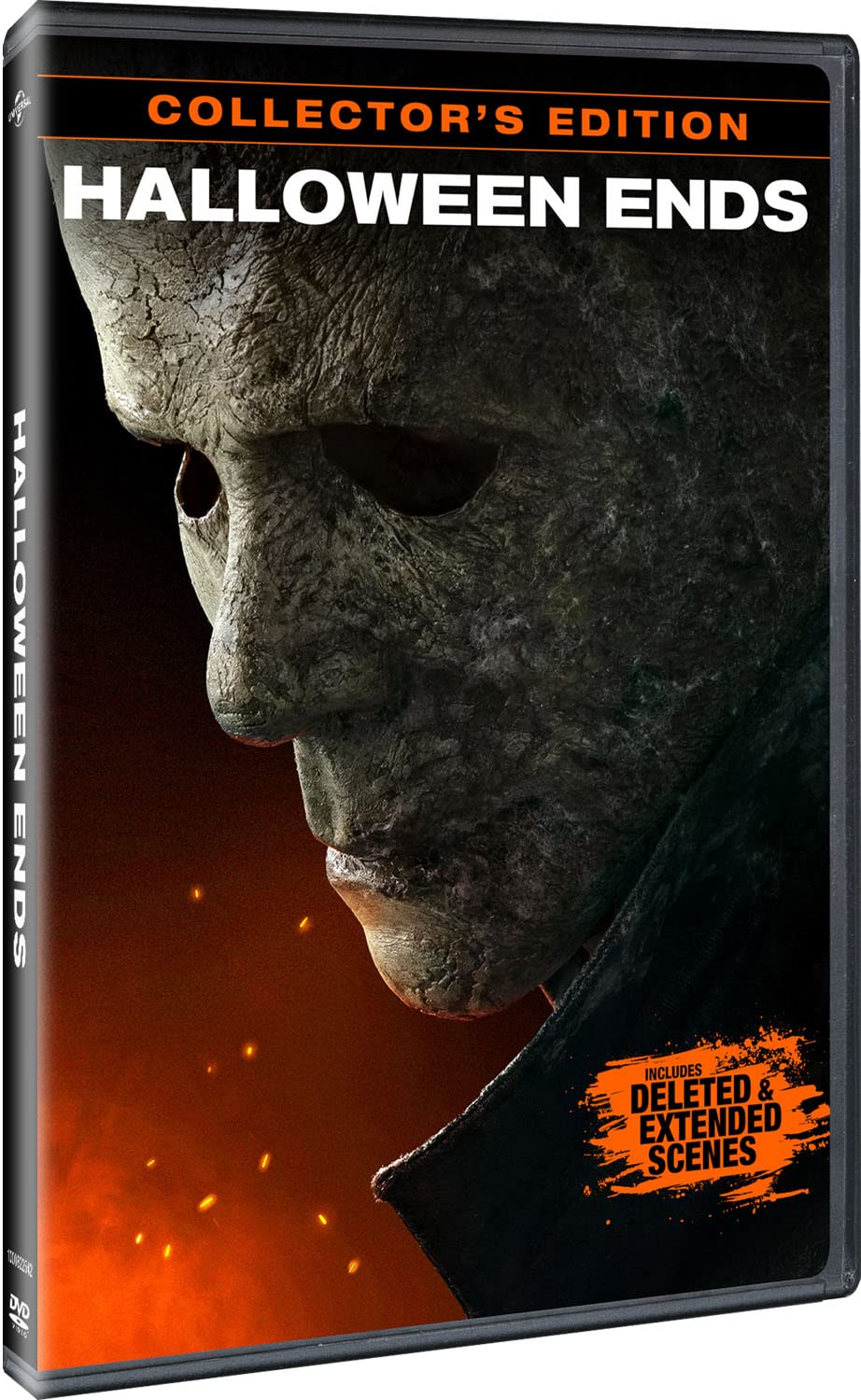
Halloween Ends (2022) – Collector’s Review Halloween Ends – Oemiu
Halloween Ends (2022) – A Collector’s Deep Dive into the Final Chapter
The legacy of Michael Myers is a tapestry woven with dread, suspense, and, perhaps surprisingly, fierce devotion. For decades, fans have followed the seemingly unstoppable evil that lurks in Haddonfield, Illinois. With *Halloween Ends*, released in 2022, the saga promised a definitive conclusion, a final confrontation between Laurie Strode and the embodiment of pure malice. But did it deliver? This collector’s review will dissect the film, examining its plot, themes, character arcs, and its place within the broader *Halloween* mythos. Beyond a simple thumbs up or thumbs down, we’ll delve into the nuances that made *Halloween Ends* such a divisive, yet undeniably impactful, entry in the slasher canon. For collectors and casual viewers alike, understanding the film’s creative choices and thematic ambitions is crucial to appreciating its place in horror history. We will be exploring everything from the intense score to the controversial plot points that have made the movie such a discussion point among horror fans. The film isn’t just an exercise in horror; it’s a commentary on trauma, fear, and the cyclical nature of evil itself.
The Narrative Gamble: A Shift in Perspective
One of the most significant departures *Halloween Ends* makes is its focus on a new character, Corey Cunningham. Four years after the events of *Halloween Kills*, Haddonfield is still grappling with the trauma inflicted by Michael Myers. Corey, a young man struggling to find his place, accidentally kills a child he’s babysitting and is subsequently ostracized and demonized by the town. This pivotal event sets him on a dark path, leading him to an encounter with the seemingly dormant Michael Myers, who now resides in the sewers of Haddonfield, weakened but still a source of potent evil. The film spends a significant portion of its runtime exploring Corey’s descent into darkness, mirroring Michael’s own descent, suggesting that evil can be a contagion, infecting vulnerable individuals. This narrative gamble, shifting the perspective away from Laurie and Michael for a substantial portion of the film, proved to be highly divisive among audiences. Some found it a fascinating exploration of trauma and the creation of a new boogeyman, while others felt it detracted from the core narrative of Laurie and Michael’s final showdown. The decision to invest so heavily in Corey’s character arc undeniably impacts the pacing and overall feel of the film, creating a different kind of horror experience compared to its predecessors. What’s undeniable is the film’s courage in attempting to subvert expectations and delve into the psychological impact of Michael’s reign of terror on a broader scale. The film also dares to ask difficult questions about the nature of evil: Is it an inherent trait, or a consequence of societal trauma and individual vulnerability? These are the concepts that make *Halloween Ends* such a complex and debated film within the franchise.
Laurie Strode’s Evolution: From Victim to Vanguard
In stark contrast to the shift in focus towards Corey, Laurie Strode’s character arc reaches its culmination in *Halloween Ends*. Having spent four decades haunted by the specter of Michael Myers, Laurie has transformed from a traumatized victim into a hardened survivalist, determined to protect her granddaughter, Allyson, and finally put an end to the cycle of violence. The film opens with Laurie writing her memoirs, reflecting on her past and grappling with the emotional scars left by Michael. This introspective approach allows the audience to connect with Laurie on a deeper level, understanding her motivations and the weight of her responsibility. Jamie Lee Curtis delivers a powerful performance, portraying Laurie as both vulnerable and fiercely resolute. She is no longer simply reacting to Michael’s actions; she is actively seeking to confront and destroy him. Her relationship with Allyson is also a central element, highlighting the intergenerational trauma that has plagued the Strode family. Laurie’s efforts to protect Allyson from the darkness that consumed her own life underscores the film’s thematic exploration of breaking free from the cycle of violence. While some critics argued that Laurie’s role was diminished compared to previous installments, her presence remains the emotional anchor of the film, driving the narrative forward and providing a sense of closure to her long and arduous journey. It is, ultimately, Laurie’s resilience and determination that serve as a counterpoint to the darkness that threatens to engulf Haddonfield, offering a glimmer of hope amidst the horror. This transformation has been a critical aspect of the series, demonstrating a character’s growth amidst unimaginable trauma.
The Final Confrontation: A Duel of Symbolism
The long-awaited final confrontation between Laurie Strode and Michael Myers in *Halloween Ends* is a brutal and visceral affair, steeped in symbolism and thematic resonance. The showdown takes place in Laurie’s kitchen, the same setting where Michael first attacked her in 1978, bringing the narrative full circle. This deliberate choice emphasizes the cyclical nature of their conflict and the enduring impact of their initial encounter. The fight choreography is raw and unforgiving, reflecting the years of pent-up rage and trauma that both characters have endured. There are no elaborate martial arts sequences; instead, the struggle is desperate and primal, a battle for survival between two individuals driven by opposing forces. Laurie, armed with her knowledge of Michael’s tactics and her unwavering determination, uses every weapon at her disposal to subdue the seemingly immortal boogeyman. The use of kitchen utensils and everyday objects as weapons further grounds the fight in reality, highlighting the ordinariness of the setting and the extraordinary circumstances of the confrontation. The film uses practical effects to full advantage, creating a sense of visceral realism that enhances the impact of the violence. The ultimate defeat of Michael Myers is not a simple kill; it is a deliberate and methodical dismantling of his physical form, symbolizing the destruction of the evil he represents. The townspeople of Haddonfield participate in this final act, carrying Michael’s body to a metal shredder and pulverizing him into nothingness, signifying the collective effort to eradicate the trauma that has haunted their community for decades. While some viewers found the ending unsatisfying, arguing that Michael’s defeat was not sufficiently epic, it is undeniably a symbolic and cathartic conclusion to the saga. The act of destroying Michael’s physical form is intended to be a moment of collective healing, where the community comes together to rid itself of the darkness that has plagued them for so long. The ultimate fate of Michael Myers in *Halloween Ends* has become a point of discussion, with fans debating the effectiveness of this conclusion.
Sound and Vision: Crafting the Atmosphere of Dread
The technical aspects of *Halloween Ends* contribute significantly to its overall impact, creating a palpable sense of dread and suspense. The score, composed by John Carpenter, Cody Carpenter, and Daniel Davies, is a masterful blend of classic *Halloween* themes and new, unsettling compositions. The familiar piano chords evoke a sense of nostalgia, while the dissonant soundscapes and electronic textures amplify the tension and create a feeling of unease. The score perfectly complements the film’s visuals, enhancing the emotional impact of key scenes and heightening the suspense during moments of action. The cinematography is equally effective, using dark, shadowy imagery to create a sense of foreboding and claustrophobia. The film’s color palette is muted and desaturated, reflecting the bleak and despairing atmosphere of Haddonfield. The use of slow-motion and close-ups during moments of violence adds to the visceral impact, immersing the viewer in the horror. The editing is deliberate and precise, building tension and suspense through carefully timed cuts and transitions. The film also makes effective use of sound design, employing a range of unsettling noises and ambient sounds to create a sense of unease. The rustling of leaves, the creaking of doors, and the distant wail of sirens all contribute to the film’s atmosphere of dread. The creative team successfully uses these elements to build and maintain tension, amplifying the sense of unease and contributing to the overall feeling of dread. The sound design of *Halloween Ends* truly elevates the experience for horror enthusiasts.
Is *Halloween Ends* a Worthwhile Addition to Your Collection?
Whether *Halloween Ends* deserves a place in your *Halloween* collection is a question of personal taste and preference. The film is undoubtedly a divisive entry in the franchise, with its narrative gamble and unconventional approach to the final showdown. However, it is also a film that attempts to grapple with complex themes of trauma, fear, and the cyclical nature of evil. For collectors seeking a definitive conclusion to the Laurie Strode and Michael Myers saga, *Halloween Ends* offers a symbolic and cathartic resolution, albeit one that may not satisfy all viewers. The film’s technical achievements, particularly its score and cinematography, are undeniable, adding to its overall impact and artistic merit. Ultimately, the decision of whether to add *Halloween Ends* to your collection depends on your willingness to embrace the film’s unconventional choices and appreciate its thematic ambitions. It is a film that demands multiple viewings and careful consideration, rewarding those who are willing to delve beneath the surface. Exploring the depths of *Halloween Ends* requires a willingness to appreciate its complexity.
| Feature | Description |
|---|---|
| Plot Focus | Shifts focus to Corey Cunningham, exploring the creation of a new boogeyman alongside the final Laurie/Michael confrontation. |
| Laurie Strode’s Arc | Culminates in a final battle, showcasing her transformation from victim to protector, grappling with intergenerational trauma. |
| Michael Myers’ Role | Depicted as weakened but still a source of evil, his ultimate defeat is symbolic and communal. |
| Sound and Vision | Score by John Carpenter elevates the tension, cinematography uses shadows and muted colors, creating a foreboding atmosphere. |
| Overall Reception | Divisive, praised for thematic exploration and technical achievements, criticized for narrative choices and pacing. |
Frequently Asked Questions (FAQ)
What is the main plot of *Halloween Ends* and how does it differ from previous films?
Does *Halloween Ends* rely heavily on gore?
*Halloween Ends* deviates from the typical slasher formula by focusing significantly on the character of Corey Cunningham. The narrative explores his descent into darkness, influenced by the lingering evil of Michael Myers. This shift in perspective, where Corey becomes a central figure alongside Laurie Strode, is a key departure from previous installments. While the movie doesn’t completely abandon the classic Laurie Strode versus Michael Myers dynamic, it dedicates substantial screen time to Corey’s transformation and the societal factors that contribute to his actions. This emphasis on a new character and the exploration of trauma and societal fear makes *Halloween Ends* a more character-driven and thematically complex film compared to its predecessors, which primarily focused on the relentless pursuit and brutal killings by Michael Myers. The final confrontation between Laurie and Michael is present, but not necessarily the exclusive focus.
How does *Halloween Ends* conclude the Laurie Strode and Michael Myers saga?
The film concludes the saga with a brutal and definitive final battle between Laurie and Michael, taking place in Laurie’s home. After a prolonged and violent struggle, Laurie manages to subdue Michael, using her knowledge of his tactics and her unwavering determination. However, the final act of destruction is a communal one. The townspeople of Haddonfield, collectively traumatized by Michael’s reign of terror, participate in his demise. They carry his body to a metal shredder and pulverize him, symbolizing the eradication of the evil he represents. This act of communal violence is intended to be a cathartic release for the town, a way to finally break free from the cycle of fear and trauma that has haunted them for decades. This ending emphasizes the collective responsibility of confronting and overcoming evil, rather than relying solely on Laurie to vanquish Michael.
What are the main criticisms of *Halloween Ends*?
Why was the plot so polarizing?
The main criticisms of *Halloween Ends* revolve around its narrative choices, particularly the heavy focus on Corey Cunningham and the perceived diminished role of Michael Myers. Many viewers felt that Corey’s storyline detracted from the core narrative of Laurie Strode and Michael Myers’ final confrontation. Some felt that Michael’s screen time was insufficient for a film billed as the “final chapter” of their saga. Others criticized the pacing of the film, arguing that it spent too much time developing Corey’s character at the expense of the traditional slasher elements. Additionally, some viewers found the ending unsatisfying, arguing that Michael’s defeat was not sufficiently epic or that the communal destruction of his body was anticlimactic. These criticisms highlight the film’s departure from the traditional *Halloween* formula and its attempt to explore more complex themes, which ultimately proved divisive among audiences.
What are the positive aspects of *Halloween Ends*?
Despite the criticisms, *Halloween Ends* also has several positive aspects. Many viewers praised the film’s thematic exploration of trauma, fear, and the cyclical nature of evil. The focus on Corey Cunningham, while divisive, was seen by some as a bold and innovative approach to the slasher genre, exploring the societal factors that can contribute to the creation of a new boogeyman. Jamie Lee Curtis’ performance as Laurie Strode was also widely praised, with many appreciating her portrayal of a strong and resilient woman grappling with decades of trauma. The film’s technical aspects, particularly its score and cinematography, were also lauded, creating a palpable sense of dread and suspense. Ultimately, the positive aspects of *Halloween Ends* lie in its thematic depth, strong performances, and technical achievements, which elevate it beyond a simple slasher film.
How does the score of *Halloween Ends* contribute to the film’s atmosphere?
The score of *Halloween Ends*, composed by John Carpenter, Cody Carpenter, and Daniel Davies, is a crucial element in creating the film’s atmosphere of dread and suspense. The score seamlessly blends classic *Halloween* themes with new, unsettling compositions. The familiar piano chords evoke a sense of nostalgia and familiarity, while the dissonant soundscapes and electronic textures amplify the tension and create a feeling of unease. The score effectively underscores the emotional impact of key scenes, enhancing the sense of foreboding and claustrophobia. It also heightens the suspense during moments of action, creating a visceral and immersive experience for the viewer. The score’s ability to evoke both nostalgia and unease contributes to the film’s overall complexity, reflecting the thematic exploration of trauma and the cyclical nature of evil.
Where does *Halloween Ends* rank within the entire *Halloween* franchise?
The ranking of *Halloween Ends* within the *Halloween* franchise is subjective and depends on individual preferences. Due to its divisive nature and unconventional narrative choices, it is generally considered one of the more polarizing entries in the series. Some fans rank it among the worst *Halloween* films, citing its focus on Corey Cunningham and the perceived diminished role of Michael Myers. Others appreciate its thematic depth and attempt to explore more complex ideas, placing it higher in their rankings. Ultimately, the ranking of *Halloween Ends* is a matter of personal taste, with some viewers valuing its thematic ambitions and others prioritizing the traditional slasher elements of the franchise.
What are some collector’s editions or special features available for *Halloween Ends*?
Collector’s editions and special features for *Halloween Ends* typically include:
* **Limited Edition Steelbooks:** These feature unique artwork and packaging, appealing to collectors.
* **Deleted Scenes:** Providing additional context or alternate takes on key moments.
* **Behind-the-Scenes Featurettes:** Offering insights into the making of the film, including interviews with the cast and crew.
* **Audio Commentary:** Featuring commentary from the director, writers, or cast members, providing additional perspectives on the film.
* **Alternate Endings:** Exploring different possibilities for the film’s conclusion.
* **Collectible Merchandise:** Such as posters, artwork cards, or figurines.
These special features enhance the viewing experience and provide collectors with a deeper understanding of the film’s production and creative choices, allowing for a richer appreciation of *Halloween Ends*.








